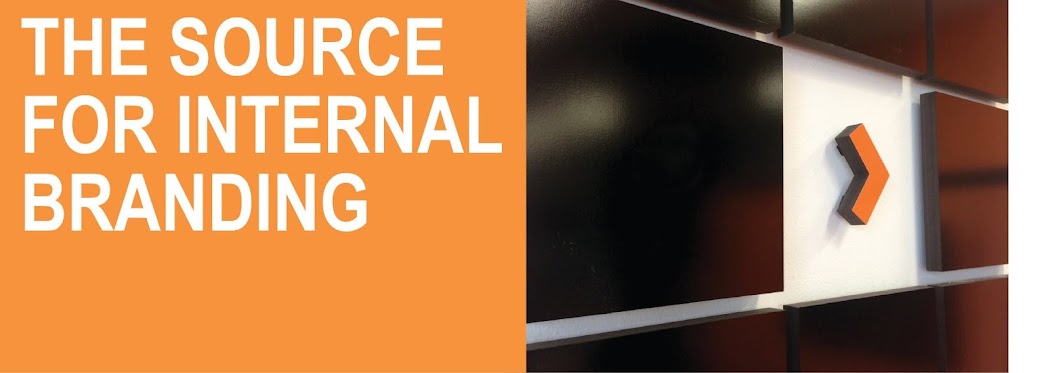It
was 14 years ago that we first started building our own brand identity. At the
time, many companies faced large-scale process redesign and reengineering programs.
Reportedly, close to 50% of those programs were failing, and 80% of the credit
was given to reasons related to company culture clashes. Our thinking? What
could we do to help organizations deal with enterprise change and internal
branding?
What
we came up with was remarkable. Instead of focusing on external audiences, we
applied traditional advertising and communications planning methods to
campaigns created for associates and employees. We offered organizations new,
exciting and relevant ways to involve, inspire and empower their internal
constituencies. By giving their employees a prominent voice, we showed them how
to make the desired changes in their companies happen. Employee engagement not
only accelerated internal acceptance but also saved a lot of money and angst.
Being able to get the job done in a quarter of the time for half the amount of
money charged by a traditional ad agency? Amazing!
Interestingly,
there’s not much difference between a company’s employees and their target
customer audience, especially in consumer segmentation. The same people who
make Campbell’s® Soup are also buying it. The key insight here? Many
of the approaches used to motivate external audiences have the same affect on a
company’s own people internally. When you look in the mirror do you see your
company’s biggest advocate and customer? Or do you see someone with doubts who
doesn’t have a voice? If you’re missing the spark necessary to move your
company forward, it’s probably time to make some changes.
Let
me offer you the 10 Commandments of Change Communications, guidelines I believe
are essential for a company’s internal branding success:
1). Engage Your People
Employees and
associates want to know they’re being heard. It’s important for them to feel
their input and efforts are valued by your organization, regardless of how big
or small contributions may be, and they want to be a part of the success, too.
2). Appreciate Effort
Show recognition
to and for the people contributing to the success of your company. Whether the
appreciation comes in the form of cash, promotions, awards or a simple
certificate, showing gratitude by acknowledging such efforts goes a long way.
3). Message with Meaning
Keep it relevant
and meaningful at all levels. It’s critical for core messaging to be aligned,
but a one-message-fits-all approach just doesn’t work. Speak to all your
constituencies – corporate, business units, field, etc. – in ways that are
appropriate and effective in order to achieve your overall goals. Messaging is
critical. Take time to make it brilliant. Once a messaging architecture is in
place, train management on expressing it in simple and convincing ways – stay
on point, repeat it frequently and build continuity. Make them believers, and
they become your best brand advocates.
4). Open Communication
If you can hear a
pin drop in a room packed with people, you’ve got a big problem. Creating a
collaborative environment where people can tell stories, share ideas and be
themselves is important. Be open to their humor, laughter and light-hearted
conversations. You’ll be amazed by what your fellow employees have to offer.
5). Train. Coach. Repeat.
Like learning,
internal branding should be viewed as a life-long process. Designed much like
curriculums used in formal education, you’re not done with internal branding
after just one exposure. Training and coaching your people until they get it
right is critical. Instead of being made up along the way, it should be
repeatable and built with content and process that incorporates learning
foundations and principles that are well thought out. It needs to be formal so
it can be enhanced year after year, allowing your people to train others so
they can train even more people.
6). Align Communications
It’s difficult to
keep core messaging aligned when multiple departments within your organization
distribute communications. Avoid the release of conflicting messaging by making
sure everyone, including public relations, advertising, human resources, sales,
recruitment and talent branding, is aligned and shares the same goals. Just
like competing messages can create confusion, so can communications with
different looks and personalities. Be sure communications are consistent with a
common look/feel, tone and personality as well.
7). Internal Branding Non-Reinvention
If done
correctly, the internal branding wheel won’t have to be reinvented each time
the evaluation process rolls around. It should be designed to be repeatable,
trainable and coachable. Tactics and messages can change with your overall
goal, but the methods and processes used to design and manage your programs
should be constant and able to withstand continuous enhancements.
8). Champion Your Brand Advocates
Use your best
brand advocates to change the way you spread the news and facilitate informal
communications within your organization. Allowing these ambassadors to make
decisions within a framework of freedom gives them the platform to champion
your cause and help convince others to embrace change. Train them. Nurture
them. Support them. And, most importantly, acknowledge them publicly for doing
a great job.
9). Lead the Way
When it’s time to
change your company’s pace, find a face employees can relate to. Choose an
internal brand sponsor, an executive company leader, who should be up to date
on the initiative at all times. In addition to being able to publicly endorse
the plan, defend it when necessary and explain it to colleagues, he/she should
also be willing and available to provide support for internal launches,
presentations and social media efforts.
10). Embrace Social Media
An effective
social media strategy doesn’t cost a fortune, and it’s very efficient for
engaging your staff in communication. Don’t be afraid. You can set community
standards and still provide a framework for freedom of expression without going
overboard with rules or legal supervision. When positioned properly, the communities
you establish will develop all of the content and bring communications to life
in a whole new way.
